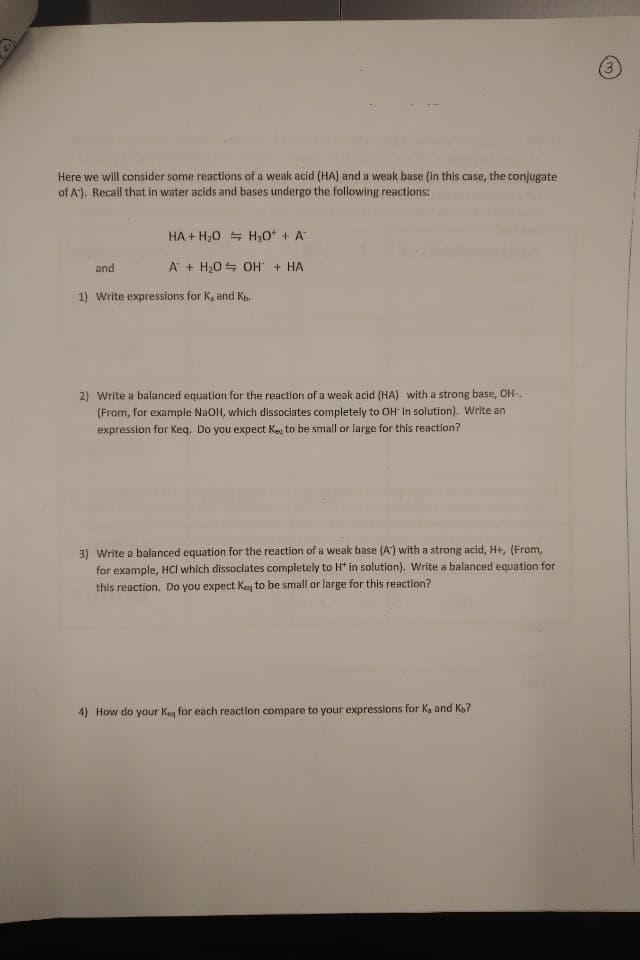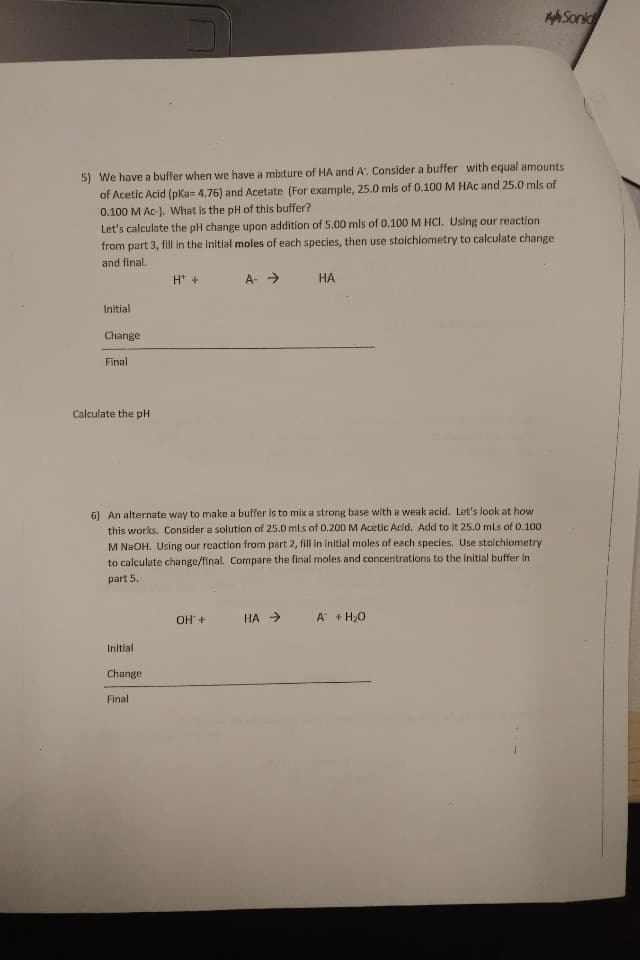Here we will consider some reactions of a weak acid (HA) and a weak base (in this case, the conjugate of A). Recall that in water acids and bases undergo the following reactions: HA+ H20 H30 + A AH20 OH HA and Write expressions for K, and Kb 1) 2) Write a balanced equation for the reaction of a weak acid (HA) with a strong base, OH- (From, for example NaOH, which dissociates completely to OH in solution). Write an expression for Keq. Do you expect Keg to be small or large for this reaction? 3) Write a balanced equation for the reaction of a weak base (A) with a strong acid, H+, (From, for example, HCl which dissociates completely to Ht in solution). Write a balanced equation for this reaction. Do you expect Keg to be small or large for this reaction? 4) How do your Keg for each reaction compare to your expressions for Ka and Kb? AASonic We have a buffer when we have a mixture of HA and A. Consider a buffer with equal amounts of Acetic Acid (pKa 4.76) and Acetate (For example, 25.0 mls of 0.100 M HAc and 25.0 mls of 0.100 M Ac-). What is the pH of this buffer? Let's calculate the pH change upon addition of 5.00 mls of 0.100 M HCl. Uslng our reaction from part 3, fill in the initial moles of each species, then use stoichiometry to calculate change and final. 5) НА H + A> Initial Change Final Calculate the pH An alternate way to make a buffer is to mix a strong base with a weak acid. Let's look at how 6) this works. Consider a solution of 25.0 mls of 0.200 M Acetic Acid. Add to it 25.0 mLs of 0.100 M NaOH. Using our reaction from part 2, fill in initial moles of each species. Use stoichiometry to calculate change/final. Compare the final moles and concentrations to the initial buffer in part 5 A +H20 ОН + HA Initial Change Final
Ideal and Real Gases
Ideal gases obey conditions of the general gas laws under all states of pressure and temperature. Ideal gases are also named perfect gases. The attributes of ideal gases are as follows,
Gas Laws
Gas laws describe the ways in which volume, temperature, pressure, and other conditions correlate when matter is in a gaseous state. The very first observations about the physical properties of gases was made by Robert Boyle in 1662. Later discoveries were made by Charles, Gay-Lussac, Avogadro, and others. Eventually, these observations were combined to produce the ideal gas law.
Gaseous State
It is well known that matter exists in different forms in our surroundings. There are five known states of matter, such as solids, gases, liquids, plasma and Bose-Einstein condensate. The last two are known newly in the recent days. Thus, the detailed forms of matter studied are solids, gases and liquids. The best example of a substance that is present in different states is water. It is solid ice, gaseous vapor or steam and liquid water depending on the temperature and pressure conditions. This is due to the difference in the intermolecular forces and distances. The occurrence of three different phases is due to the difference in the two major forces, the force which tends to tightly hold molecules i.e., forces of attraction and the disruptive forces obtained from the thermal energy of molecules.
5) and 6)


Trending now
This is a popular solution!
Step by step
Solved in 2 steps with 2 images




